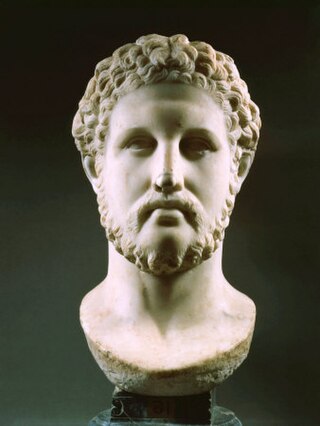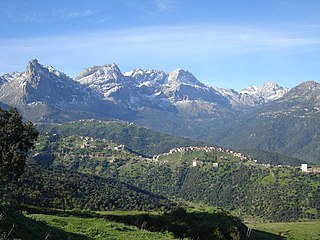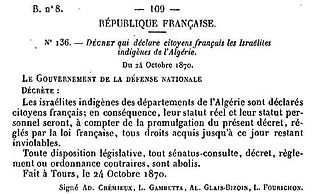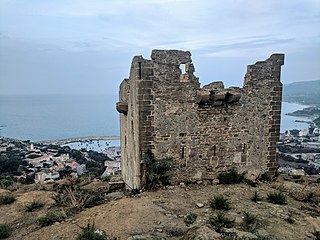Related Research Articles

North Africa is a region encompassing the northern portion of the African continent. There is no singularly accepted scope for the region, and it is sometimes defined as stretching from the Atlantic shores of the Western Sahara in the west, to Egypt and Sudan's Red Sea coast in the east.

Berbers or the Berber peoples, also called by their contemporary self-name Amazigh or Imazighen, are a diverse grouping of distinct ethnic groups indigenous to North Africa who predate the arrival of Arabs in the Arab migrations to the Maghreb. Their main connections are identified by their usage of Berber languages, most of them mutually unintelligible, which are part of the Afroasiatic language family. They are indigenous to the Maghreb region of North Africa, where they live in scattered communities across parts of Morocco, Algeria, Libya, and to a lesser extent Tunisia, Mauritania, northern Mali and northern Niger. Smaller Berber communities are also found in Burkina Faso and Egypt's Siwa Oasis.

Divide and rule policy, or divide and conquer, in politics and sociology is gaining and maintaining power divisively. This includes the exploitation of existing divisions within a political group by its political opponents, and also the deliberate creation or strengthening of such divisions.

The Maghreb, also known as the Arab Maghreb and Northwest Africa, is the western part of the Arab world. The region comprises western and central North Africa, including Algeria, Libya, Mauritania, Morocco, and Tunisia. The Maghreb also includes the disputed territory of Western Sahara. As of 2018, the region had a population of over 100 million people.

Kabylia or Kabylie is a mountainous coastal region in northern Algeria and the homeland of the Kabyle people. It is part of the Tell Atlas mountain range and is located at the edge of the Mediterranean Sea.

Al-Kahina, also known as Dihya, was a Berber queen of the Aurès and a religious and military leader who led indigenous resistance to the Muslim conquest of the Maghreb, the region then known as Numidia, notably defeating the Umayyad forces in the Battle of Meskiana after which she became the uncontested ruler of the whole Maghreb, before being decisively defeated at the Battle of Tabarka. She was born in the early 7th century AD and died around the end of the 7th century in modern-day Algeria. She is considered one of the most famous figures in the history of the Berber resistance to the Arab conquest in the 7th century.

Berberism is a Berber political-cultural movement of ethnic nationalism, started mainly in Kabylia (Algeria) and in Morocco later spreading to the rest of the Berber communities in the Maghreb region of North Africa. The Berberist movement in Algeria and Morocco is in opposition to cultural Arabization, the pan-Arabist political ideology and Islamism.

The Sanhaja were once one of the largest Berber tribal confederations, along with the Zanata and Masmuda confederations. Many tribes in Algeria, Burkina Faso, Libya, Mali, Mauritania, Morocco, Niger, Senegal, Tunisia and Western Sahara bore and still carry this ethnonym, especially in its Berber form. Other names for the population include Zenaga, Znaga, Sanhája, Sanhâdja and Senhaja.

The Berber Spring was a period of political protest and civil activism in 1980, claiming recognition of the Berber identity and language in Algeria, with events mainly taking place in Kabylia and Algiers.
Arabized Berbers are Berbers whose language is a local dialect of Arabic and whose culture is Arab culture, as a result of Arabization. Currently, most Arabized Berbers identify as Berber, although the prominence of Arab influences has fully assimilated them into the Arab cultural sphere.

The Kabyle people are a Berber ethnic group indigenous to Kabylia in the north of Algeria, spread across the Atlas Mountains, 160 kilometres (100 mi) east of Algiers. They represent the largest Berber population of Algeria and the second largest in North Africa.
The document known as the Berber Dahir is a dhahir (decree) created by the French protectorate in Morocco on May 16, 1930. This Dahir changed the legal system in parts of Morocco where Berber languages were primarily spoken, while the legal system in the rest of the country remained the way it had been before the French invasion. Sultan Muhammad V signed the Dahir under no duress, though he was only 20 years old at the time.
The Berber Latin alphabet is the version of the Latin alphabet used to write the Berber languages. It was adopted in the 19th century, using varieties of letters.

The Crémieux Decree was a law that granted French citizenship to the majority of the Jewish population in French Algeria, signed by the Government of National Defense on 24 October 1870 during the Franco-Prussian War. It was named after French-Jewish lawyer and Minister of Justice Adolphe Crémieux.

Ethnic groups in Algeria include Arabs and Berbers, who represent 99% of the population, of which 75–85% are Arab and about 15–25% are Berber. Algeria also has a minority population of Europeans that represents less than 1% of the population. The minority European population is predominantly of French, Spanish, and Italian descent.

The French conquest of Algeria took place between 1830 and 1903. In 1827, an argument between Hussein Dey, the ruler of the Regency of Algiers, and the French consul escalated into a blockade, following which the July Monarchy of France invaded and quickly seized Algiers in 1830, and seized other coastal communities. Amid internal political strife in France, decisions were repeatedly taken to retain control of the territory, and additional military forces were brought in over the following years to quell resistance in the interior of the country.

Auguste Hubert Warnier was a French medical doctor, journalist and politician who spent most of his career in Algeria. At first he was a Saint-Simonian and was sympathetic to the local population. He thought the Berbers had Germanic blood and a civilization derived from Roman and Christian origins, so could readily adapt to French civilization. He had no respect for the Arab "intruders". Later he took the view that the indigenous people had destroyed the once-fertile environment of Algeria, became a proponent of French colonization and opposed the "Arab Kingdom" policy of Napoleon III. In his last years he was a Representative in the National Assembly for the Province of Algiers. He was responsible for a law that allowed expropriation of land or forced sale to colonists.

The Battle of the Col des Beni Aïcha (1846) or Battle of Thénia (1846), which broke out on 3 February 1846, was a battle of the French conquest of Algeria between the Algerian rebels, and the France, which was the colonial power in the region since 1830.

The Second Assault of Dellys was an assault by troupes coloniales under General Thomas Robert Bugeaud (1784–1849) against the Algerian resistance fighters in the town of Dellys, Kabylia of the Igawawen. It was part of the French conquest of Algeria and took place in April–May 1844.
Omar ben Zamoum was a Kabyle marabout who participated to the Algerian resistance during Mokrani Revolt against the French conquest of Algeria.
References
- 1 2 3 4 Tilmatine, Mohand (2016-01-01). "French and Spanish colonial policy in North Africa: revisiting the Kabyle and Berber myth". International Journal of the Sociology of Language. 2016 (239). doi:10.1515/ijsl-2016-0006. ISSN 0165-2516.
- 1 2 3 Burke, Edmund (December 2007). "France and the Classical Sociology of Islam, 1798–1962". The Journal of North African Studies. 12 (4): 551–561. doi:10.1080/13629380701633414. ISSN 1362-9387.
- 1 2 Silverstein, Paul A. (2002), "The Kabyle Myth: Colonization and the Production of Ethnicity", From the Margins, Duke University Press, pp. 122–155, doi:10.1215/9780822383345-005, ISBN 978-0-8223-2861-2 , retrieved 2022-08-30
- 1 2 3 4 Burke, Edmund III. The ethnographic state: France and the invention of Moroccan Islam. p. 33. ISBN 978-0-520-95799-2. OCLC 906782010.
- 1 2 3 Lazreg, Marnia. "The Reproduction of Colonial Ideology: The Case of the Kabyle Berbers." Arab Studies Quarterly, vol. 5, no. 4, 1983, pp. 380–95. JSTOR, http://www.jstor.org/stable/41857696. Accessed 31 Aug. 2022.
- 1 2 Islam in the West. OUP India. 2018. p. 250. ISBN 978-0-19-909366-3.
- ↑ Eugène., Daumas (1847). La Grande Kabylie: Études historiques (in French). Vol. i. p. 77. ISBN 978-2-346-05496-1. OCLC 1041018616.